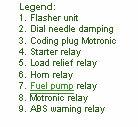
Driver’s Side Fuse Box Diagram Of Hyundai Santa Fe 2010 internet marketingCircuit guide about Fuse Box Diagram Of 2002 Kia Optima. The parts fuse panel consist of: Instrument Cluster, Rear Wiper Relay, Rear Wiper Motor, Multifunction Switch (Wiper), Burglar Alarm Relay, Power Window Main Switch, Rear Power Window Switch LH, Power Window main Switch, Passenger...































